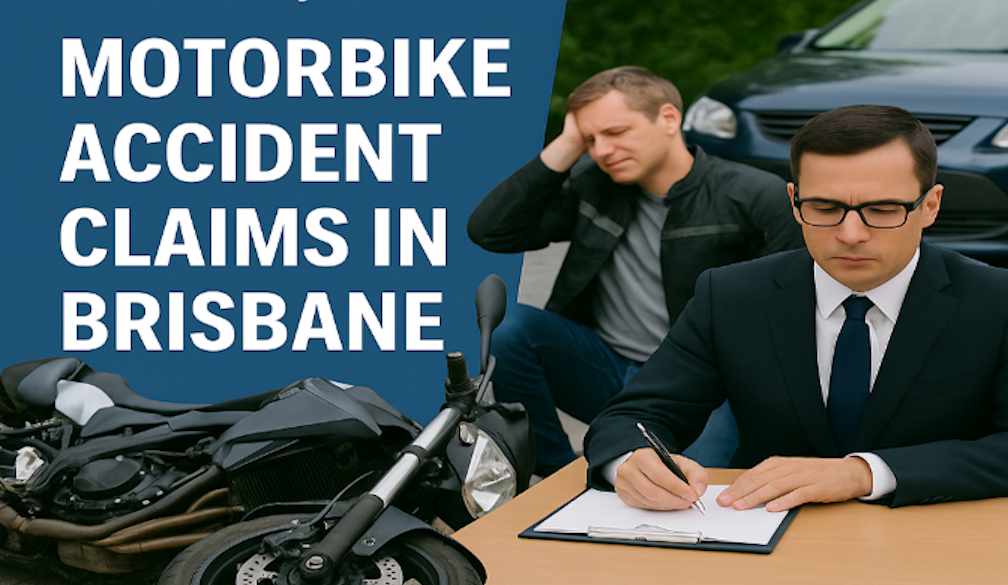Brisbane Motor Vehicle Accident Lawyers & Motorbike Accident Claims

Motorbike accidents in Brisbane can lead to severe injuries and complex legal challenges, given the vulnerability of riders on the road. For Australian locals, navigating motorbike accident claims in Queensland requires understanding local laws and securing expert legal support. Brisbane motor vehicle accident lawyers specialise in helping victims of motorbike accidents secure the compensation they deserve, guiding them through the claims process with expertise. This article, tailored for Australian locals using Australian English, provides a detailed overview of motorbike accident claims in Brisbane, covering eligibility, the claims process, legal support.
Understanding Motorbike Accidents in Brisbane
Motorbike accidents often result in more serious injuries compared to car accidents due to the lack of protective barriers for riders. In Brisbane, these accidents frequently occur on busy routes like the M1 Pacific Motorway, Coronation Drive, or scenic roads popular with riders, such as Mount Glorious. The city’s mix of urban congestion and suburban sprawl, combined with its subtropical climate, creates unique risks for motorcyclists.
Common Causes of Motorbike Accidents
Several factors contribute to motorbike accidents in Brisbane:
- Driver Negligence: Car drivers failing to see motorbikes, often due to blind spots or distracted driving (e.g., using a mobile phone).
- Road Hazards: Wet roads during Brisbane’s rainy season, potholes, or gravel on corners, particularly in areas like Mount Nebo.
- Speeding: Both motorbike riders and other drivers speeding, reducing reaction time.
- Failure to Yield: Drivers not giving way at intersections, such as in the busy Brisbane CBD.
- Rider Error: Inexperienced riders or those not wearing proper safety gear, like helmets, can contribute to accident severity.
Identifying the cause is critical for establishing liability, which can involve the rider, another driver, or even road authorities in cases of poor maintenance.
Types of Injuries and Damages
Motorbike accidents often result in severe injuries due to the exposed nature of riders. Common injuries include:
- Fractured bones, particularly in the arms, legs, or collarbone.
- Road rash, ranging from mild abrasions to deep tissue damage requiring skin grafts.
- Head injuries, including concussions or traumatic brain injuries (TBIs), even with a helmet.
- Spinal injuries, potentially leading to partial or full paralysis.
- Psychological trauma, such as anxiety or post-traumatic stress disorder (PTSD).
Damages extend beyond physical harm:
- Medical expenses for emergency care, surgeries, and rehabilitation.
- Loss of income due to time off work, sometimes permanently if injuries are severe.
- Pain and suffering, reflecting the emotional and physical toll.
- Property damage, including repair or replacement of the motorbike and gear.
Eligibility for Motorbike Accident Claims in Queensland
In Queensland, motorbike accident victims can seek compensation if they meet specific criteria. Understanding eligibility is the first step to a successful claim.
Who Can Claim Compensation?
You may be eligible for compensation if:
- You were injured in a motorbike accident on a public road or related area, such as a carpark.
- The accident involved a registered vehicle, including your motorbike or another vehicle.
- Your injuries resulted directly from the accident, not a pre-existing condition (though aggravation of prior injuries can be claimed).
- You were not entirely at fault. Queensland’s comparative negligence system allows you to claim even if partially responsible, with compensation reduced proportionally.
Eligible claimants include:
- Motorbike riders injured by another vehicle or road hazard.
- Passengers on the motorbike.
- Pedestrians or cyclists struck by a motorbike.
- Drivers of other vehicles involved in the crash with a motorbike.
- Dependents in fatal accident cases, who may claim for loss of financial support.
Time Limits for Claims
Queensland law sets strict deadlines for motorbike accident claims:
- General Limitation Period: You must file a claim within three years from the accident date.
- CTP Notification: You need to notify the at-fault party’s Compulsory Third Party (CTP) insurer within nine months, unless a reasonable excuse for delay is provided (e.g., delayed injury diagnosis).
- Minors: The limitation period starts when they turn 18.
- Fatal Accidents: Dependents typically have three years from the date of death to claim.
Missing these deadlines can bar your claim, so acting promptly is essential.
Types of Motorbike Accident Compensation Claims
Compensation claims in QLD fall into two main categories, each addressing different aspects of your losses.
Compulsory Third Party (CTP) Claims
All registered vehicles in Queensland, including motorbikes, must have CTP insurance, which covers personal injuries. A CTP claim can provide compensation for:
- Medical expenses, including hospital bills, surgeries, and physiotherapy.
- Loss of income during recovery.
- Reasonable travel costs for medical appointments.
CTP claims are suitable for minor to moderate injuries but may not cover non-economic damages like pain and suffering unless the injury meets a threshold for significance.
Common Law Claims
If another party’s negligence caused the accident, such as a car driver or road authority, you may pursue a Common Law claim. These claims allow for:
- General damages for pain and suffering, based on the injury’s severity.
- Economic loss, including future earning capacity if injuries limit your ability to work.
- Future medical costs, such as ongoing rehabilitation or home modifications.
Common Law claims often yield higher payouts but require clear evidence of negligence and significant harm, making legal support crucial.
The Role of Brisbane Motor Vehicle Accident Lawyers
Brisbane motor vehicle accident lawyers bring specialised expertise to motorbike accident claims, helping victims navigate Queensland’s legal system and secure fair compensation.
How Lawyers Maximise Compensation
Experienced lawyers ensure all losses are accounted for:
- They calculate economic damages using medical bills, pay slips, and receipts to cover past and future losses.
- They assess non-economic damages, such as pain and suffering, often consulting medical experts to quantify long-term impacts.
- They negotiate with insurers to counter low settlement offers, ensuring a fair payout.
For example, if a motorbike accident causes a spinal injury, a lawyer might secure compensation for surgery, ongoing care, lost wages, and emotional distress, ensuring no aspect of your loss is overlooked.
Legal Process Guidance
The claims process involves several steps, and lawyers provide structured support:
- Initial Consultation: They assess your case and determine the best claim type (CTP or Common Law).
- Evidence Gathering: They collect police reports, medical records, witness statements, and any available dashcam or CCTV footage.
- Claim Submission: They file the claim with the CTP insurer or court, ensuring all deadlines are met.
- Negotiation: They handle discussions with insurers to secure a fair settlement.
- Court Representation: If a settlement isn’t reached, they represent you in court, presenting a compelling case to a judge.
This guidance simplifies a complex process, allowing you to focus on recovery.
Selecting the Right Lawyer
Choosing a Brisbane lawyer with experience in motorbike accident claims is key to success. Look for:
- Experience: A lawyer familiar with motorbike accident cases and QLD laws will navigate complexities effectively.
- Communication: They should explain legal terms clearly and keep you updated throughout the process.
- No Win, No Fee Arrangements: Many Brisbane lawyers offer this, meaning you pay no upfront fees unless your claim succeeds. Always confirm potential costs, such as disbursements, in writing.
Reputable local firms like Maurice Blackburn or Carter Capner Law, with offices in Brisbane, are trusted options. The Queensland Law Society also provides referrals to qualified professionals.
Motorbike Accident Claims Process
The process for claiming compensation after a motorbike accident involves several key steps, requiring careful attention to detail.
Steps to Lodge a Compensation Claim
- Report the Accident: Notify the police if there are injuries or significant damage, within 24 hours for serious incidents in Queensland.
- Seek Medical Attention: Visit a doctor to document your injuries, even if they seem minor, as some may develop later.
- Notify the Insurer: Contact the at-fault party’s CTP insurer within nine months, with your lawyer’s assistance.
- Lodge a Formal Claim: Submit a claim form detailing the accident, injuries, and losses.
- Negotiate a Settlement: Your lawyer will negotiate with the insurer for a fair payout.
- Court Action (if needed): If no agreement is reached, the case may proceed to court.
Gathering Evidence and Documentation
Strong evidence is crucial for a successful claim. Collect:
- Photos of the accident scene, motorbike damage, and any visible injuries.
- Contact details of witnesses and their statements about the crash.
- Medical reports and bills to prove the extent of your injuries.
- Police reports to establish fault and circumstances.
- Receipts for expenses like medication, motorbike repairs, or travel to medical appointments.
Organise these documents in a folder for easy access during the claims process.
Time Limits and Legal Deadlines
Adhering to deadlines is critical:
- The three-year limitation period starts from the accident date.
- The nine-month notification period to the CTP insurer is strict, though extensions may be granted with a valid reason (e.g., delayed injury diagnosis).
Consulting a lawyer early ensures these timelines are met, preventing claim dismissal.
Maximising Your Motorbike Accident Compensation
Achieving fair compensation requires understanding your entitlements, factors affecting your claim, and how to handle disputes.
Calculating Compensation Entitlements
Compensation for motorbike accidents covers:
- Medical Costs: Hospital stays, surgeries, physiotherapy, and medication.
- Lost Income: Wages lost during recovery and potential future earnings if injuries impact work capacity.
- Pain and Suffering: Based on the injury’s severity and.Concurrent conversations are not supported. To start a new conversation, please end the current one by saying "End conversation."





